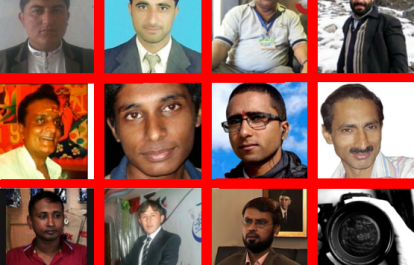Attacks on Media
South Asia’s battle with impunity
09 Nov, 2015
On November 2, the world marked the International Day to End Impunity for Crimes against Journalists. The International Federation of Journalists (IFJ) launched the Global and the Asia-Pacific regional campaigns that will see activities and events to raise awareness on the dire situation of impunity and press for justice for journalists across the globe throughout November. The IFJ campaigns will conclude on November 23, the anniversary of the Ampatuan Massacre in the Philippines in which at least 32 journalists were killed.
For a long time the South Asia region has been the worst region in the world in terms of impunity for crimes against journalists. Despite all eight countries in the region – Afghanistan, Pakistan, India, Sri Lanka, Bangladesh, Nepal, Maldives and Bhutan – being under democratic regimes for at least five years, the persistence of impunity in these countries has remained a big challenge for governments and democracy.
UNESCO says that ‘only one in 12 cases of killed journalists has been resolved’ globally, and the situation in the South Asia is even worse. Indeed, because the region has an almost perfect record of impunity the murderers of journalists often walk free, and in most of the cases, even investigations into the cases prove elusive.
This trend is reflected in the CPJ’s Impunity Index, which lists five South Asian nations, namely Sri Lanka, Afghanistan, Pakistan, Bangladesh and India, among the14 countries with the worst records in punishing journalists’ murderers.
Sri Lanka maintains a perfect record of impunity in journalist killings. Although there haven’t been any killings of journalists since 2009, neither have we seen any prosecution of the killings that took place before. Two iconic examples of this are the murder of popular editor Lasantha Wickramatunga and the disappearance of cartoonist Prageeth Eknelygoda – both of which remain unsolved along with other cases.
Pakistan has long been among the most dangerous countries in the world for journalists as 95 journalists and media workers have lost their lives since 2005. From 2010 to 2015, 67 journalists and media workers were killed – that is, one journalist killed every month.
A total of 117 journalists have been murdered since 2000 in Pakistan and only two cases – that of the American journalist Daniel Pearl and the Geo News reporter Wali Khan Babar – have been prosecuted. Within Pakistan, Balochistan, termed the Cemetery for Journalists in the IFJ South Asia Press Freedom Report 2014, remains the most dangerous province for journalists with 29 killings since 2007. The situation is so dangerous in Balochistan that a judicial commission set up by the provincial government to investigate six of the 19 murder cases of journalists since 2011, failed to find any evidence to fix responsibility for the killings of Balochistan’s journalists due to the lack of specific laws on protection of witnesses and safety of journalists, and poor standards of investigating agencies.
In Afghanistan, the CPJ states that no perpetrators have been held responsible in any of the targeted killings that took place in Afghanistan since 2005.
India is the largest democracy in the world and free from involvement in a major armed conflict. Yet, its record on punishing the murderers of journalists is dismal. With 31 murders of journalists since 2010 and 83 since 1990, and without justice in most of the cases, impunity is rife in India.
The Press Council of India, in its 2015 special report, noted that among 80 cases of journalist murders since 1990, justice has been delivered in only one case – that of gang rape and murder of a female journalist in Mumbai. It said in most of the cases, that either the cases are pending in the courts or the police are yet to file charges. The journalist associations have been demanding a separate law for the protection of journalists and speedy prosecution in cases of murders.
In Nepal, 35 journalists were killed since 2001 and four other disappeared yet a new UNESCO report states that only 6 cases have been taken to prosecution and others are not even being investigated. As most of the cases happened during the Maoist-conflict, there is not willingness from the state to investigate the incidents.
Maldivian journalist Ahmed Rilwan Abdulla disappeared in August 2014. Rilwan’s disappearance and the Maldives Police’s inability to find reliable information on his whereabouts highlight the situation in the Maldives where attacks against media are not thoroughly investigated.
Killing a journalist is a cowardly act; and many of the journalists who were murdered lost their life because of their job – that of bringing truth out to inform the public. Murders of journalists have multilayered impact on society, as it’s chilling effect is felt both by living journalists, who in absence of justice, are forced to restrict themselves – either by self-censorship or by safety measures; and society as a whole, for it is faced with the risk of not hearing the truths that must be known.
To safeguard democratic values on which societies are founded, it’s essential that governments act to protect freedom of expression and prosecute all those responsible its violation. Furthermore, murder is the gravest crime against humanity and any state or government should not remain passive when it comes to punishing the murderers. Unless the nations in the South Asia take serious and bold steps in ending impunity for the crimes against journalists, they will remain untrue to the spirit of democracy.
By Ujjwal Acharya, IFJ South Asia coordinator. @UjjwalAcharya
Join the IFJ #EndImpunity campaign tagging #IFJ and demand action for the slain journalists across the world. #Whatareyoudoing?
IFJ campaign: bit.ly/IFJendimpunity
IFJ impunity resources: bit.ly/IFJimpunityresources
Written By
Comments
Resources
- IFJ South Asia Media Bulletin, February 2023 02/15/2023 Download
- IFJ South Asia Media Bulletin, January 2023 01/18/2023 Download
- Nepal Press Freedom report 2022 01/03/2023 Download

